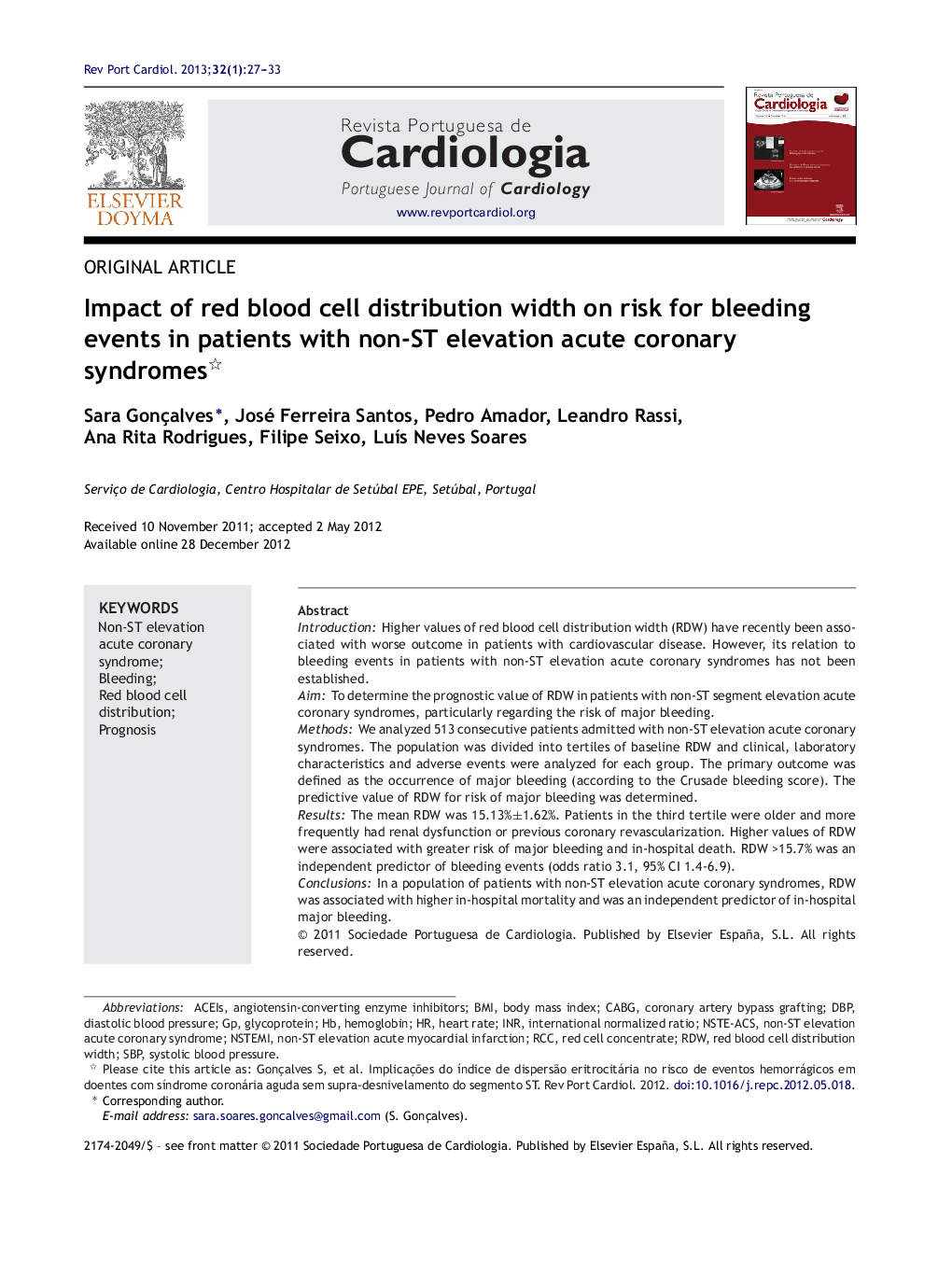| کد مقاله | کد نشریه | سال انتشار | مقاله انگلیسی | نسخه تمام متن |
|---|---|---|---|---|
| 3020751 | 1182323 | 2013 | 7 صفحه PDF | دانلود رایگان |

IntroductionHigher values of red blood cell distribution width (RDW) have recently been associated with worse outcome in patients with cardiovascular disease. However, its relation to bleeding events in patients with non-ST elevation acute coronary syndromes has not been established.AimTo determine the prognostic value of RDW in patients with non-ST segment elevation acute coronary syndromes, particularly regarding the risk of major bleeding.MethodsWe analyzed 513 consecutive patients admitted with non-ST elevation acute coronary syndromes. The population was divided into tertiles of baseline RDW and clinical, laboratory characteristics and adverse events were analyzed for each group. The primary outcome was defined as the occurrence of major bleeding (according to the Crusade bleeding score). The predictive value of RDW for risk of major bleeding was determined.ResultsThe mean RDW was 15.13%±1.62%. Patients in the third tertile were older and more frequently had renal dysfunction or previous coronary revascularization. Higher values of RDW were associated with greater risk of major bleeding and in-hospital death. RDW >15.7% was an independent predictor of bleeding events (odds ratio 3.1, 95% CI 1.4-6.9).ConclusionsIn a population of patients with non-ST elevation acute coronary syndromes, RDW was associated with higher in-hospital mortality and was an independent predictor of in-hospital major bleeding.
ResumoIntroduçãoNíveis elevados de índice de dispersão eritrocitária (RDW) têm sido recentemente associados a um pior prognóstico em doentes com doença cardiovascular. A sua relação com o risco de eventos hemorrágicos em doentes com síndrome coronária aguda sem supradesnivelamento do segmento ST não está, no entanto, estabelecida.ObjetivoDeterminar o valor prognóstico do RDW em doentes com síndrome coronária aguda sem supradesnivelamento do segmento ST em particular sobre o risco de hemorragia major.MétodosForam estudados 513 doentes consecutivos internados com o diagnóstico de síndrome coronária aguda sem supradesnivelamento do segmento ST. A população foi agrupada segundo os tercis da distribuição do RDW e caracterizada de acordo com as características clínicas, laboratoriais e eventos adversos. O evento primário foi definido como a presença de hemorragia major durante o internamento (definida pela classificação do registo Crusade). Determinou-se o valor preditor do RDW sobre o risco de hemorragia major.ResultadosO RDW médio foi de 15,13 ± 1,62%. Os doentes incluídos no terceiro tercil apresentaram uma idade mais avançada e mais frequentemente disfunção renal ou antecedentes de revascularização coronária. Valores crescentes de RDW associaram-se a um aumento do risco de hemorragia major e de mortalidade hospitalar. Um valor de RDW > 15,7% foi um preditor independente de eventos hemorrágicos (odds ratio ajustado 3,1, IC 95% 1,4-6,9).ConclusõesNuma população de doentes com síndrome coronária aguda sem supradesnivelamento do segmento ST, o RDW esteve associado a uma maior mortalidade intra-hospitalar, tendo constituído um fator de risco independente para hemorragia major intra-hospitalar.
Journal: Revista Portuguesa de Cardiologia (English Edition) - Volume 32, Issue 1, January 2013, Pages 27–33